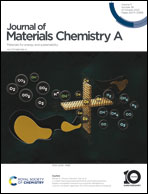In situ construction of AFe2O4/Fe2O3 (A = Cd, Ca, Zn) array structures for selective detection of VOCs†
Abstract
Interface engineering has become an effective strategy to enhance the performance of functional materials. But, the poor charge transfer efficiency of the heterogeneous interface will severely limit the performance of the gas sensor. The construction of novel Fe2O3/AFe2O4 (A = Cd, Ca, Zn) array structures with heterogeneous interfaces in the same coordination environment may break this limitation. In this paper, the Fe2O3/AFe2O4 (A = Cd, Ca, Zn) array material is developed as an integrated gas sensor to selectively identify single or mixed VOC gases (ethanol, triethanolamine, and acetone). The density functional theory (DFT) calculations also confirmed the reason for the array material's single selectivity. The establishment of the built-in electric field will promote electron redistribution and charge transfer at the active interface, thus enhancing the response to VOC gases. Finally, the sensitization mechanisms of the composites were investigated in detail by combining characterization techniques. The general strategy for constructing novel Fe-based spinel array structures was proposed for the first time.



 Please wait while we load your content...
Please wait while we load your content...